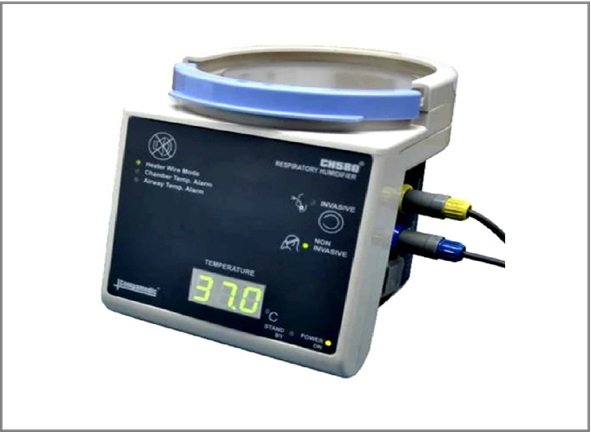What is Respiratory Gas Humidifier?

In medical contexts, a respiratory gas humidifier is a device that adds moisture to the air a patient breathes. This is crucial because, particularly in patients undergoing oxygen therapy or mechanical ventilation, dry air can irritate the respiratory system and create pain or difficulties.
Types of Respiratory gas humidifier
- Passover Humidifiers: Before the gas is given to the patient, it can absorb moisture in a pool of water by passing a stream of gas over it.
- Bubble Humidifiers: The gas is made more humid before it reaches the patient by bubbling oxygen or air through water in these humidifiers.
- Heated Humidifiers: These gadgets add water vapour to the gas flow by heating the water. They are frequently used with mechanical ventilators to provide warm, humid air to patients.
- Ultrasonic Humidifiers: These produce a thin mist of water droplets by ultrasonic vibrations, which are then combined with the dry gas flow to provide humidity. In settings for home-based respiratory therapy, ultrasonic humidifiers are frequently utilized.
FDA Code for Respiratory Gas Humidifier
| Device Name | Regulation Number | Product Code | Class |
| Humidifier, Respiratory Gas, (Direct Patient Interface) | 868.5450 | BTT | Class 2 |
FDA 510K documents for Respiratory Gas Humidifier
- FDA Medical Device User Fee Cover Sheet
- FDA Premarket Review Submission Cover Sheet
- FDA 510(k) Cover Letter
- FDA 510(k) Indications for Use Statement
- FDA 510(k) Summary or FDA 510(k) Statement
- FDA Truthful and Accuracy Statement
- FDA Class III Summary and Certification
- Financial Certification or Disclosure Statement
- Declarations of FDA Conformity and Summary Reports
- FDA 510 (k) Executive Summary
- Medical Device Description
- FDA 510(k) Substantial Equivalence Discussion
- Proposed Labeling
- Sterilization and Shelf Life
- Biocompatibility
- Software
- Electromagnetic Compatibility and Electrical Safety
- Performance Testing-Bench
- Performance Testing-Animal
- Performance Testing-Clinical
In both Traditional and Abbreviated 510(k) submissions, the FDA advises including the listed section headings in the recommended sequence. Although certain sections may not apply to your device, maintaining the specified order of headings is suggested by the FDA to facilitate expedited reviews.
FDA 510k test requirements for Nebulizer
Tests required for respiratory gas humidifier.
The tests required for a respiratory gas humidifier would generally fall under biocompatibility testing, electrical safety testing, and performance testing. Here’s a breakdown of these tests:
- Biocompatibility Testing
- Cytotoxicity Testing
- Sensitization and Irritation Testing
- Systemic Toxicity Testing
- Genotoxicity Testing
- Sub chronic and Chronic Toxicity Testing
- Risk Management
- Chemical Characterization
- ISO 18562-2:2017 – Particulate Matter
- ISO 18562-3:2017 – VOC Compounds
- ISO 18562-4:2017 – Leachable in Condensate
- ISO 18562-1:2017 “Biocompatibility evaluation of breathing gas pathways in healthcare applications
- Part 1: Evaluation and testing within a risk management process.
- Electrical Safety and Software Testing
- Electrical Safety Compliance (e.g., IEC 60601)
- Electrical Insulation Testing
- Ground Continuity Testing
- Medical device software – software lifecycle processes
- Medical device software – software lifecycle processes – IEC 62304:2015
- Medical Electrical Equipment and System Electromagnetic Immunity Test for Exposure to Radio Frequency Identification Readers – An AIM Standard – Standard 7351731 Rev. 2.00 2017-02-23
- Performance Testing
- Humidification output, thermal overshoot, surface temperature of applied parts in line with ISO 80601-2-74:2017
- Resistance to flow, compliance, and gas leak testing in line with ISO 5367:2014
- Comparative ME systems testing in line with ISO 80601-2-12:2020
- Comparative Disposable Exhalation Port leak rate
- Comparative testing of MDI port performance
- Pressure Control
- Alarm Testing
- Additional Testing
- Anaesthetic and respiratory equipment – Breathing sets and connectors – ISO 5367:2014
- Anaesthetic and Respiratory Equipment – Conical Connectors – Part 1: Cones and Sockets. – ISO 5356-1:2004
- Human Factors / Usability